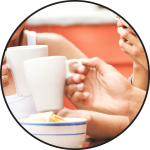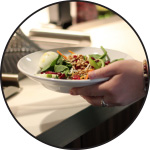Rate this article and enter to win
OK fine—so we shouldn’t grab a soda or donut on our way to our first class. But when we’re in a hurry, sleepy, stressed, or all out of willpower, junk food is just so…there for us. What can we do about that?
In a recent survey by Student Health 101, more than 7 out of 10 students acknowledged that the accessibility of foods significantly influences how you eat. Science agrees. Our “choices” have far more to do with our environment than we realize, according to a large body of research. What we eat and drink is often our default response to the sights and smells all around us.
If our eating is driven by forces beyond our consciousness, are we helpless to change it? No. The trick is to reduce our exposure to unhealthy cues and introduce cues that help us eat healthfully. This is about tweaking our own environments—effortlessly.
Know your environmental cues
Vending machines, packaged snacks, the oversized mac & cheese in the dining hall, the candy wrapper on the sidewalk, the burger ads that flash up on Instagram—these negative “nudges” can make unhealthful eating our default behavior, especially when we’re low on energy.
But we can flip that script by substituting positive “nudges.” When we make our options healthier, we get healthier, says a 2012 study in the Journal of Public Health.
Even seemingly insignificant environmental tweaks can have a powerful effect on how we eat. In a famous experiment at the Google offices, researchers aimed to reduce employees’ consumption of M&Ms®. Simply putting the candies into opaque containers and making healthier snacks more visible resulted in a dramatic drop in candy consumption—even though the M&Ms® didn’t go away.
How to make it effortlessly easier
Here’s the key to developing any new habit: Make it easier to do the desired behavior and more difficult to do the undesired behavior. Think about your eating this way:
Which eating habits do you want to change? When are they happening, and in what context?
Example: Stressed in the evenings and pining for a pint of Gargantuan Gobs of Gorgeousness? Need a spoon to relax at night? Notice the patterns.
Next: How can you change that context? How can you substitute different cues without adding work?
Examples:
- Move the Gargantuan Gobs to the back of the freezer. When we can’t see it, we probably won’t eat it, according to Slim by Design: Mindless Eating Solutions for Everyday Life (HarperCollins, 2014), by Dr. Brain Wansink, a leading expert in eating behaviors.
- Or don’t purchase Gargantuan Gobs. It may be easier to make one decision (“I won’t buy that this time”) than a series of decisions (“Should I eat that again?”).
- Substitute: Put grapes or chopped veggies in a bowl on your counter or desk.
Food industry tricks: Which foods to store out of sight and out of reach
The food industry understands and makes the most of the physiological cues (taste, texture, and so on) that drive our eating habits. Michael Moss, author of Salt, Sugar, Fat: How the Food Giants Hooked Us (Random House, 2013), talked with SH101 and broke down the primary components of an irresistible snack.
- Salt “It sends an almost instant signal to the reward signal of your brain, which is designed to get you to want and desire and seek out food. Those centers in turn send a signal back that says, ‘I love that, get me more.’”
- Mouthfeel Imagine “biting into a warm, toasted, melted cheese sandwich. [Fat] gives it a meltability so that it feels luscious in your mouth.” That creamy, soothing sensation is known as mouthfeel, and it’s why nearly half of the calories in snack foods come from fat.
- Sugar “Doritos and other potato chips can have lots of sugar in them in the form of starch. That’s one of the most treacherous sugars, because it’s processed quickly and it also goes to the pleasure centers of our brains.”
- Sound The satisfying crunch of a chip is no coincidence. Food scientists have engineered just the right amount of noise. The theory is that “the more noise [chips] make, the more you’ll want to eat them.”
- Sensory-specific satiety Ever enjoyed a food but decided you were sick of a flavor? That’s sensory-specific satiety. Food scientists override the impulse to stop eating by making sure that no one flavor stands out. That way, your brain never flashes a stop sign.
- Bliss point The food industry puts all these together and arrives at the bliss point. Think of the bliss point as the top of a bell curve—peak deliciousness. “Euphoria’s not too strong a word. It’s why the deck is stacked against us.”
Should we try to give up all those foods? Probably not. “There is no good or bad food, no right or wrong. It’s just fuel for the body,” says Alexa Schmidt, a registered dietitian who works with students at Binghamton University at the State University of New York. “The trick is to strike a balance in an environment that makes unhealthy foods easier to find.”
Science-based hacks for eating healthy without thinking about it
 |
Hacks for your room or apartment |
- Keep less healthy foods out of sight and hard to reach: Clear your counters (except for fruit); favor opaque containers and high-up shelves; wrap cake and pizza in aluminum foil and tuck them in the back of the fridge.
- Make healthier options more accessible: Keep a fruit bowl on your counter and keep the eye-level shelf in your refrigerator stocked with the foods you aim to eat more of.
- Divide large snack items (e.g., a family-size bag of chips) into smaller serving-size packages before you start munching.
- Use narrower glasses and smaller dishes: Serve drinks in taller/slimmer glasses and choose narrow wine glasses over wide ones. Downsize your dishes: The smaller the plate or bowl, the less you’re likely to eat.
Eat from smaller packages: In a 2007 study, participants who were given snacks in large packages consumed 30–50 percent more than those who were given the same food in smaller packages. But they vastly underestimated the difference that the package size made to their eating, according to the Journal of the American Dietetic Association.
Our funky eating habits: check out the evidence
Make the healthy stuff visible: A 2002 study suggested we are three times more likely to eat the first food we see in the cupboard than we are to eat the fifth food we see (Journal of Marketing Research).
Snack small: Lighter snacks leave us feeling just as full after 15 minutes as if we’d eaten a larger portion, according to a 2013 study in Food Quality and Preference.
Drink tall: In a 2005 study in the British Medical Journal, bartenders poured 30 percent more alcohol into short, wide tumblers than they poured into highball glasses, when mixing the same drink.
Downsize your dishes: The smaller the bowl, the less you’re likely to eat, according to a 2012 study in the Journal of Nutrition Education and Behavior.
 |
Hacks for the restaurant |
- Request a window seat: Avoid dark tables, booths, bar seating, and the TV zone.
- Skip the bread—or at least the butter. Ask for olive oil instead.
- In a fast food restaurant, it’s different: Head for a dim, quiet corner.
- Be the last at your table to start eating.
- Eat mindfully and be aware of the influence of subtle cues, and your own expectations, on how much you eat and drink.
Eat mindfully: In a 2007 experiment, restaurant diners were offered free wine. Some were given wine with a Californian label; the others got a North Dakotan label. The diners who thought their wine was Californian (perceived as high quality) lingered longer and ate more food than those who got the vintage from North Dakota (perceived as low quality). All diners were in fact served the same wine (“Two Buck Chuck” by Charles Shaw). When we eat mindlessly, our experience conforms with our expectations, researchers concluded (Physiology & Behavior).
What else is going on here? Researchers’ findings
Mind the bread: The bread on the table often adds up to a large chunk of our meal consumption, according to a 2003 study in the International Journal of Obesity. In the study, people who were served bread with olive oil ate less bread overall. People who were served butter instead of olive oil ate far more bread—maybe because we tire of olive oil sooner than butter.
Request a window seat: In studies, diners ordered healthier foods if they sat by a window or in a well-lit part of the restaurant. At a dark table or booth, they ordered heavier food, and more of it; close to a TV, they ordered more fried foods, writes Dr. Wansink in Slim by Design: “People sitting furthest from the front door ate the fewest salads and were 73 percent more likely to order dessert.”
At fast food places, it’s different: Find a dim corner. A 2012 study in Psychological Reports found that lowering the lighting and playing mellow music (Miles Davis instead of Aerosmith) resulted in customers eating less.
Be the last to start eating: When we eat with others, we pace ourselves according to how quickly or slowly they are eating, and we match our food consumption to theirs, writes Dr. Brian Wansink in Mindless Eating: Why We Eat More Than We Think (Bantam Dell, 2006).
 |
Hacks for the dining hall |
- Scan your options before selecting what to eat, then serve yourself on a salad plate rather than a dinner plate.
- Watch what you’re eating—literally. Let the chicken bones and empty containers stay on the table until you’re done.
- Sit with the slow eaters to manage your pace.
- Sit with your back to the food counter.
- Check your mood: If you’re upset, breathe deep and think calming thoughts before approaching the self-serve counter.
Watch what you’ve eaten: In a study involving 53 students and large supplies of chicken wings on Super Bowl Sunday, researchers found that when wait staff let the chicken bones pile up on the table, students ate fewer wings; when the chicken bones were removed, students kept eating. The experiment shows the association between visual cues and how much we eat, according to Perceptual and Motor Skills (2007).
Think you wouldn’t do this? You probably would
Don’t rely on your appetite to tell you when to stop: In a 2005 experiment, researchers invited students to lunch, gave them soup, and during the meal secretly refilled their soup bowls via a hidden under-the-table tube. The students didn’t notice the subterfuge, and ended up eating an average 15 oz. soup each, compared to the 9 oz. that other students ate from normal (non-bottomless) bowls (Obesity Research).
Eat with the slowbies: In an experiment, when an undercover researcher ate more cookies, so, inevitably, did their unsuspecting companion (Psychological Bulletin, 2003). To lower your rate of consumption, hang out with slow eaters.
Check out all the food options before selecting what you eat: This helps with weight management, according to a 2008 study published in the journal Obesity.
Look away: People who sat facing the food were more likely to get up and grab seconds than were those who put temptation out of sight and out of mind, according to the 2008 study in Obesity. The same study found that serving yourself on a smaller plate also assisted with weight management.
Calm down before you self-serve: In a series of studies, when participants were in a bad mood, their food priorities shifted: Instead of focusing on food that would fuel them up and taste great, they picked high-fat, high-sugar, high-salt bombs, according to the Journal of Consumer Psychology (2014).

 |
Noelle Vuong is a fourth-year undergraduate at Humber College in Ontario majoring in nursing; Student Health 101 Student Advisory Board 2015-16. |
“Fooducate goes beyond calorie counting. It tracks exercise, debunks food myths, and teaches you a thing or two about the food industry. Talk about convenient.”
Useful?
In school, healthy habits can go down the drain (Cup Noodles at midnight, anyone?). But the grading system keeps you conscious of how healthy your choices really are.
Rating: 4/5 stars
Fun?
What other app connects you to people just to talk about food? I like that you can befriend other users and see what they are eating.
Rating: 3/5 stars
Effective?
My snacks changed from potato chips (my ultimate Achilles’ heel) to fresh fruits and veggies.
Rating: 4/5 stars
 |
 |
Switch up your food cues: Cornell University
Tested food apps and trackers: Wellocracy
Personalized food and exercise SuperTracker: US Dept. of Agriculture [USDA]
Mindless Eating: Why We Eat More Than We Think: Brian Wansink
Bantam Dell, 2006
Slim by Design: Mindless Eating Solutions for Everyday Life: Brian Wansink
HarperCollins, 2014

























